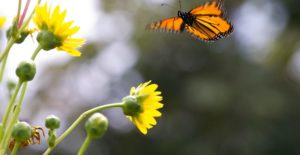How You Can Help Save the Monarchs
 Not long ago, spring and summer in Illinois were marked by reappearance of clouds of orange and black wings. The Eastern Monarch butterfly was adopted as Illinois’ state insect because the entire state lies in its spring and fall migration path across the Midwest. Every Illinois school kid could identify the Monarch because they were so common across our rural and urban landscapes. For most of us, that is what we thought of when we thought of caterpillars and butterflies.
Not long ago, spring and summer in Illinois were marked by reappearance of clouds of orange and black wings. The Eastern Monarch butterfly was adopted as Illinois’ state insect because the entire state lies in its spring and fall migration path across the Midwest. Every Illinois school kid could identify the Monarch because they were so common across our rural and urban landscapes. For most of us, that is what we thought of when we thought of caterpillars and butterflies.
Sadly, this is no longer true. This summer many Illinoisans counted only a few Monarch sightings. The Eastern Monarch is now threatened to the point of endangerment. As a migrating species the Monarch relies on the prevalence of its host plant, milkweed, to reproduce, and native flowering plants blooming in large expanses across the Midwest landscape to feed during its journey from Mexico to Canada and back each year. Their once expansive prairie habitat has given way to paved development, and increased use of pesticides and herbicides have removed the Milkweed and native flowering prairie plants they rely on to reproduce and feed across their Midwest flyway. This is a problem for Illinois’ native bee populations as well. The U.S. Fish and Wildlife Service is now assessing the Monarch butterfly and Illinois’ Rusty Patched Bumblebee for endangered species status.
Prairie Rivers Network is working with a coalition of partners on an Illinois plan—an element of a larger regional and tri-national plan—to re-establish plentiful habitat across Illinois for the Monarch and other native pollinators. Illinois teams are focusing on habitat opportunity areas in different land categories across the state: roadways and rights of ways, agricultural lands, and established conservation areas. There is a team focused on open lands in the Chicago area. PRN is assembling a team focused on engaging downstate cities and towns to expand and protect Monarch habitat. We are encouraging Illinois Mayors to sign the Mayors Monarch Pledge that was initiated by the National Wildlife Federation, which asks Mayors to make commitments in their towns to expand and protect Monarch habitat. And we are now seeking schools, faith communities, businesses, and other institutions to consider incorporating Monarch habitat on their grounds and encouraging them to help educate community members about the Monarch and how they can help protect its habitat. This year Illinois established a new license plate sticker to call attention to Monarch protection, but enough people must register for the sticker to get the program up and running. (Learn more about the Monarch Illinois license plate here.)
Here’s how YOU can help! Become a Monarch Ambassador!
- Encourage your Mayor to sign the pledge. If your Mayor has signed the pledge, help friends in a neighboring town ask their Mayor to sign the pledge. Getting kids organized to ask their Mayor to sign the pledge is a great civic engagement experience, too.
- Organize a Pollinator Protector Coalition in your town to get the word out about the need to plant pollinator gardens, direct pollinator gardeners to good resources and work for habitat protection practices.
- Contact local schools about establishing a school garden for Monarchs and other pollinators. If you are a gardener, offer to help students learn how to plant and maintain the garden. IDNR has a grant program for school garden habitat and your local Soil and Water Conservation District may be able to help you obtain the right seed mix that includes adequate Milkweed.
- Do you have a favorite walking trail that would be a great continuous border for Monarchs? Contact the land owner or manager and ask how you can help them get a pollinator garden planted.
- Work with your faith community to incorporate Monarch gardens on their grounds. Many faith communities are incorporating the Monarchs’ journey as a metaphor for the spiritual journey. Maybe you can start an interfaith Monarch team in your community.
- Ask businesses and business parks to incorporate Monarch habitat on their grounds. This is a great way for businesses to meet sustainability goals. Deep-rooted Milkweed and native flowering plants help to soak up excess water, sediment and nutrients from stormwater runoff, keeping these pollutants that harm fish and cause toxic algae blooms out of our creeks, rivers and drinking water. Write a letter to the editor of your local paper thanking businesses that incorporate and protect pollinator habitat in their landscapes and encouraging others to get on board.
- Work with your neighbors to plant Pollinator Pocket gardens around your neighborhood. The U of I Extension has developed guidance on plant selection, installation and maintenance. If you register your garden on their website, you can purchase a sign that lets your community know your native plant garden is a welcoming spot for Monarchs and other pollinators. Save Milkweed and other seeds from your pollinator pocket gardens to share with new gardeners.
- Encourage your local nurseries to carry pollinator plants including Milkweed and Butterfly weed that are not grown or treated with neonicotinoid pesticides throughout the growing season. Let them know that you’ll promote them to Monarch gardeners in the community, then find ways to do that.
- Help us at PRN expand our pollinator protection efforts by becoming a sustaining donor. Your can also give a gift membership to someone you love as a birthday or holiday gift in honor of a future filled with fluttering Monarchs and buzzing bees. We’ll send them our beautiful notecards with their gift membership.







